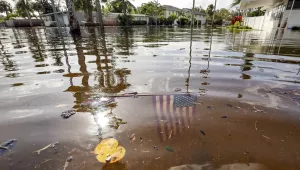To: POTUS
CC: Janet Napolitano/DHS; Kathleen Sebelius/HHS; Hilda Solis/Labor;
Arne Duncan/Education; Tom Vilsack/Agriculture
BCC: Craig Fugate/FEMA; John Brennan/HSCT
Subject: Before Disaster Strikes: Rate and Raise Public Preparedness Now
Summary: The American public is not prepared for major disasters. That will prove costly, including to the federal government, as more and new types of disasters are expected to occur. The new Security Council Resilience Directorate - Preparedness, as one of its first initiatives, should task the Department of Homeland Security (DHS) to work with federal and non-federal stakeholders and independent experts to:
- Develop agreed measures of public preparedness, and
- Develop and execute cost-effective, innovative approaches for ensuring timely progress in preparedness.
In the revamped federal agency performance measurement system, public preparedness should be deemed a high priority measure for DHS, as well as for selected other departments who need to be made federal partners in this effort. The new Directorate should monitor the establishment of and progress in these measures.
Background: More, more severe, and new types of disasters can be expected to occur as a result of new types of threats (e.g., biological, cyber, nuclear/radiological) and more as well as more severe threats due to increased global interconnectedness and climate change. Yet, most Americans are not adequately prepared to respond to or recover from a catastrophic disaster, and many expect the government to take care of them. Even those who have experienced many common disasters such as earthquakes and hurricanes may not make appropriate preparations or exercise proper judgment in responding to new disasters that may require different responses. Although community disaster preparation is considered the purview of state and local governments, when a disaster strikes, the federal government is often called in to respond or to help with recovery. For example, New Orleans estimates that the federal government role in rebuilding that city will be $15 billion. Although all rebuilding costs cannot be averted, better citizen preparation and community standards have been shown to reduce the costs of catastrophes.
Preparedness not only reduces response and recovery requirements but also increases American resilience, which could help deter intentional attacks. Indeed, many commissions and studies have noted the importance of effectively engaging the public in prevention and preparedness, for members of the public are the first responders.
Nonetheless, American preparedness is neither formally measured nor officially monitored and is believed to lag behind that of other countries. One reason for this is confusion over responsibilities. Although the federal government has an important role to play in ensuring preparedness, it has generally pursued this role through state and local governments rather than directly, as the federal government has no constitutional authority to regulate public health and safety. The federal government does provide grants to encourage states and communities to achieve broad emergency management goals; however, outcome measures related to the public's preparedness are missing. The federal National Preparedness Guidelines do include "Community Preparedness and Preparation" as a target capability, but the National Response Framework does not focus to any significant degree on the general public. And state and local governments in turn often consider themselves service providers rather than aggressive public enablers.
The attempts of the federal government itself to increase public preparedness have been generally limited to its ready.gov campaign and its support for efforts such as the Community Emergency Response Teams (CERTs). Most recently, however, the Federal Emergency Management Agency (FEMA) has committed to a new attitude toward public engagement that includes an enhanced online approach.
These efforts may be necessary but not sufficient. Thus far, these have been relatively passive efforts to engage the public, and their effectiveness is unknown as no measures of public resilience have been agreed and utilized. In 2005, the American Red Cross and the Council for Excellence in Government, working with others, did devise some agreed but straightforward measures of what people need to know and to have done to be prepared; on the most recent "Readiness Quotient" (RQ) survey, the country still did not score well. The Emergency Preparedness Institute, a private corporation primarily of media and insurers, using RQ and other indicators developed a "preparedness clock," noted the problems with the lack of consistent surveys but also noted time was running out to prepare for the next catastrophe. Government, private sector, and public agreement needs to be forged on what constitutes proper public preparedness for multiple threat scenarios based on specific geographic and population vulnerabilities.
The DHS Strategic Plan rightly states the importance of public readiness to ensuring homeland security but omits any survey measures to report on this goal or major programs to achieve it. Having goals without measures is like sending your child to school and not getting a report card: you hope progress is being made, but you can never be sure. Past DHS leaders have bemoaned the public's unwillingness to prepare despite its efforts. However, more than cajoling is needed: better public preparedness may be accomplished if new innovative techniques are used to attract and engage the public and if specific goals with clear accountability measures are established.
Recommendation:
- Task DHS to work with stakeholders to develop well-considered measures of public preparedness and then to be responsible with those stakeholders for establishing and achieving target levels of preparedness, with regular reporting to the public and to the new Security Council Resilience Directorate (Preparedness), which should monitor outcomes.
- Make public preparedness a high-priority measure for selected agencies in the new federal performance system.
Next Steps: The new White House Preparedness Directorate should direct DHS to lead this effort and other federal stakeholders to participate and should monitor progress, including by ensuring that public preparedness is part of target agencies' and departments' performance evaluation. DHS should designate an individual/office responsible for the public preparedness effort and its outcomes. The office would:
- Establish an initial process plan to effect the effort
- Identify the key stakeholders that need to participate at different points and how
- Determine some initial broad preparedness baselines with available measures and establish interim goals for process implementation and for desired outcomes
- Ensure qualified public affairs and emergency preparedness staff lead the efforts
- Consider establishing a Program Management Office (PMO) to work across departments, levels of government and projects, including related projects such as the Integrated Public Alert and Warning System
- Coordinate the development of agreed measures of levels of public preparedness, with attention given to the different needs of populations and of regions at different times, and to the desirability of the approaches
- Review past and current efforts to establish measures
- Consider lessons learned from other countries' and U.S. historic and regional efforts at public preparedness, including performance and costs
- Involve emergency preparedness specialists in and out of government in developing a range of target capabilities that individuals and families should have (building off of the approaches of the Target Capabilities List for communities and the Cost-to-Capability initiative)
- Involve communities and the private sector in the discussions at different levels of government, including with elected officials, to gain insight into current baseline capabilities and potential desirable levels
- Develop, evaluate, and execute agreed approaches for ensuring timely progress in these measures, with agreed milestones for different stakeholders' contributions and for public preparedness target outcomes based on community requirements
- Brainstorm innovative approaches for achieving ranges of target capabilities. Can the private sector be leveraged, e.g., through the sale of pre-packaged disaster supplies and instruction manuals? Should DHS underwrite disaster preparedness programming on cable television with private industry producers who could make it into a compelling view and/or support the development of educational video games? What roles should schools and workplaces have in the plan? How can Web 2.0 and community organizers best be utilized?
- Evaluate the alternative approaches for potential costs, benefits, and risks
- Gain agreement on stakeholder roles and timetables for program execution
- Monitor progress, review program needs, and report back to the Security Council and the public.
This need not be an overly complex effort. Establishing initial basic measures and targeting some simple gains may greatly reduce risks.
This Policy Brief was prepared by Debra K. Decker, Associate, International Security Program/Project on Managing the Atom at Harvard Kennedy School's Belfer Center for Science and International Affairs. She can be contacted at: Debra_Decker@hks.harvard.edu.
STATEMENTS AND VIEWS EXPRESSED IN THIS POLICY BRIEF ARE SOLELY THOSE OF THE AUTHOR AND DO NOT IMPLY ENDORSEMENT BY HARVARD UNIVERSITY, THE JOHN F. KENNEDY SCHOOL OF GOVERNMENT, OR THE BELFER CENTER FOR SCIENCE AND INTERNATIONAL AFFAIRS.
Decker, Debra. “Before Disaster Strikes: Rate and Raise Public Preparedness Now.” Belfer Center for Science and International Affairs, Harvard Kennedy School, June 2009





